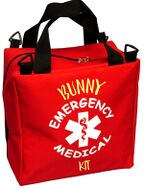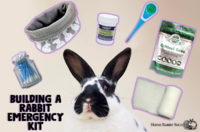First aid kit for rabbits

The following is a list of some home remedies you may try before rushing your rabbit to the vet and are useful to have on hand. Please remember this is not intended to replace professional expert veterinary care. It should not be used to make a "do-it-yourself" diagnosis. Only a qualified, rabbit-knowledgeable veterinarian can determine exactly what your bunny's illness is and recommend treatments.
Wound care
Please see First aid for rabbits#Wound care for more tips on how to treat wounds at home.
| Product | Common Uses |
|---|---|
| styptic powder, cornstarch, or baking flour | Stops the bleeding of nails cut too close to the quick. Not for use on skin.[1] Can be found in drug and pet stores. |
| A&D Original Ointment, Bag Balm, plain diaper rash ointment, silvadene cream, calendula lotion or ointment, or Balmex or Desitin ointment | Used to topically treat minor sores and irritation. Try to use types of ointment with no zinc, aloe, or other additions because they may cause harm to rabbits in some cases.[2] A more extensive list can be found of the bottom of the page here. Can be found in drug stores. |
| Vetericyn Wound & Skin Care, Betadine, polyhydroxydine solution, chlorhexidine solution, or hydrogen peroxide | Used to disinfect and clean minor wounds and scratches. Dilute hydrogen peroxide and chlorhexidine solution for use.[1] Hydrogen peroxide should not be used in deep cuts or punctures due to the risk of gas embolism.[3][4] Can be found in drug stores. |
| Cavilon No Sting Barrier Film swabs and spray | Used to protect bald spots from friction injuries. |
| triple antibiotic (e.g. Neosporin) | Used to treat wounds. Do not use Neosporin Plus or with pain relief as corticosteroids can be dangerous to use for rabbits.[1][2] Can be found in drug stores. |
| sterile saline solution, Vetericyn Eye Wash | Used to flush foreign matter out of eyes. Can be found in drug stores. Please see this Rabbitors article for more examples of safe eye rinses for rabbits. |
| non-adherent pads | Used to dress wounds. Can be found in drug stores. |
| self-adherent gauze | Used to bandage wounds without sticking to fur. Can be found in drug stores. |
| soft e-collar, medical shirt, or newborn one-piece | Used to keep rabbits from irritating reachable surgery incisions while recovering. See E-collars for more information. Can be found at veterinarians and pet stores. |
GI treatment
| Product | Common Uses |
|---|---|
| Probios, BeneBac, or other probiotics | Used to restore the balance of GI flora. Can be found in pet and feed stores. |
| infant simethicone (liquid form) | Relieves minor gas symptoms or diarrhea. Can be found in drug and grocery stores. Please see this Rabbitors article for examples of safe simethicone brands for rabbits. |
| small jars of plain baby food with no additives or preservatives | Used to give tablet medications or as a calorie supplement for rabbits that are not eating. Use apple sauce, fruit mix baby foods, or canned pumpkin. Do not use pumpkin pie filling with spices, only 100% pumpkin. In the event that none of the previously listed can be found, use a lactose-free plant-based blend.[5] Can be found in grocery stores. |
| Oxbow Critical Care, Oxbow Critical Care Fine Grind, Science Selective Recovery Plus, Emeraid Sustain | A premium recovery food which can be syringe-fed to rabbits that are unwilling to eat their normal diet due to illness, surgery or poor nutritional status. This specially formulated product contains all the essential nutrients of a complete diet as well as high-fiber timothy hay to ensure proper gut physiology and digestion.[6] Can be found in some pet stores or from online retailers. |
| medicine dropper and oral syringes (10 ml, 20 ml, or 60 ml) | Used to administer liquids, medication, or food that have been liquefied in the event that a rabbit stops eating. 3cc is enough for most medication, and 15cc or larger is recommended for assist feeding. Can be found in drug stores or pet stores. |
| Snuggle Safe Pet Bed Microwave Heating Pad, portable hand warmers, small flexible electric heating pad | Used to comfort the rabbit and provide warmth to encourage digestive action. Wrap with a clean towel for use. |
| Cisapride (Propulsid) or metoclopramide (Reglan) | Intestinal motility agents. Available by prescription from your local rabbit veterinarian. |
| Meloxicam (Metacam, Meloxidyl) | An NSAID that reduces pain and inflammation. Available by prescription from your local rabbit veterinarian. |
| Lactated Ringer's Solution & fluid administration set | optional. Training by a veterinarian is required for use.[1] |
Multi-use
| Product | Common Uses |
|---|---|
| non-adherent pads | Used to dress wounds. Can be found in drug stores. |
| self-adherent gauze | Used to bandage wounds without sticking to fur. Can be found in drug stores. |
| eye dropper or oral syringe | Used to administer liquids, medication, or food that have been liquefied in the event that a rabbit stops eating. 3cc is enough for medication, and 5cc or larger is recommended for hand feeding.[1] Can be found in drug stores. |
| Pedialyte or oral rehydration salts | Used to rehydrate and keep hydrated. |
| vinegar | Used to clean cages, dishes, and trays. Vinegar will remove hard water and calcium build ups. Also acts as a mild disinfectant. Can treat wet dewlap by reducing the pH preventing the overgrowth of the bacteria Pseudomonas.[7] Can be found in grocery stores. |
| heating pad or hot water bottle | For shock or hypothermia. Remember to wrap the bottle in the towel so it does not burn the rabbit. Can be found in drug stores. |
| cotton swabs, cotton balls | Used to clean scent glands and wounds. Dip in diluted solution of hydrogen peroxide to clean glands.[7] Can be found in drug stores. |
| pill crusher or pill splitter | optional. Used to make pills easier to feed to a rabbit. |
| soft towels | Used to dry or secure your rabbit. |
| scissors | Used to carefully trim the fur around a wound. Buy round- or blunt-tipped scissors to minimize risk of injury to your rabbit. Rabbit skin is very delicate. |
| tweezers | Used to pick out maggots in the event of flystrike. |
| ice |
Diagnostics
| Product | Common Uses |
|---|---|
| digital infant rectal thermometer | Used to take temperature. Should go up to at least 106°F or 41°C. Apply lubricant and gently insert into rectum. Normal rabbit temperature is 101-103°F. |
| petroleum jelly, KY jelly or other lubricant | Used as a lubricant to use with thermometer. |
| rubbing alcohol | Used to disinfect thermometer. |
| stethoscope | optional. Used to listen to gut sounds. |
| otoscope | optional. Used to check inside ears. |
Miscellaneous
| Product | Common Uses |
|---|---|
| food-grade cornstarch | Used for spot cleaning and "dry baths" to clean a messy bottom due to runny stool or urine leakage. |
| flea comb | Used to safely get rid of a mild case of fleas. After each combing, dip the comb in warm soapy water to rinse and kill the fleas. |
| bromelain, papaya tablets | Used during high-shed seasons as a preventative treatment to move hair through the digestive system. Do not use on a daily basis or once GI stasis has developed. Mix 1/4 tsp of bromelain in drinking water.[7] If using papaya tablet as supplements, do not feed any other sugary treats. Count the supplement as a treat.
There is some debate about the usefulness of these enzymatic products, however. As Dr. Anna Meredith writes,[8]
Ferrets, Rabbits, and Rodents: Clinical Medicine and Surgery also notes,[9]
Dana Krempels, Mary Cotter, and Gil Stanzione write,[10]
|
Suppliers

The following are some places you can purchase a ready-made emergency kit for rabbits.
- Erin Urano, Custom Emergency Kits - Bunny Emergency/1st Aid Kits on Facebook (US)
- House Rabbit Resource Network, Rabbit Emergency Kit (US)
- Napoleon Bunnyparte, Rabbit Emergency Kit (US)
Here are some stickers that you can use to decorate a homemade first aid kit.
- SS Bunny Imports, First aid kit vinyl rabbit sticker
First aid storage boxes:
- Manor Pet Housing, 1st Aid Box/Grooming Box
Amazon shopping list:
- Bunny Supportive Care Kit, by Kinenchen
Further reading

- Kinenchen. (2013). Visual Guide to Drugstore Remedies for Common Bunny Problems
- Zooh Corner Rabbit Rescue. Rabbit Emergency Kit
- Heartland Rabbit Rescue. Rabbit First Aid Kit [PDF]
- Spooky & Scully's Blog. (2014). Bunny First Aid Kit
- House Rabbit Network. Emergency Kit- What’s in it?
- Buns Inc. Essential Bunny Emergency Repair Kit [PDF]
See also
References
- ↑ 1.0 1.1 1.2 1.3 1.4 1.5 Smith, K. (2003). Rabbit Health in the 21st Century. (2nd ed.).
- ↑ 2.0 2.1 Minnesota Companion Rabbit Society, What to Have in Your Bunny First Aid Kit
- ↑ Zooh Corner. (2014). Rabbit Medical Emergencies. Retrieved 07 March 2016 from http://www.mybunny.org/info/rabbit-medical-emergencies/
- ↑ Oliveria et al. (2012). Pulmonary Gas Embolism in Rabbit Caused by Hydrogen Peroxide — Case Report. Ars Veterinaria, 28(4), 255-259.
- ↑ Happy Hoppers Rabbit Forum, Rabbit First Aid Kit
- ↑ Oxbow Animal Health, Critical Care
- ↑ 7.0 7.1 7.2 Barbi Brown's Bunnies, Rabbit Owner's Medicine Chest
- ↑ Rabbit Welfare Association & Fund. (2010). The Rabbit digestive system: A delicate balance. Retrieved 7 Mar 2016 from http://rabbitwelfare.co.uk/pdfs/ROWinter10p7.pdf
- ↑ Quesenberry, K & Carpenter, J. (2012). Ferrets, Rabbits, and Rodents: Clinical Medicine and Surgery. (3rd ed.).
- ↑ Krempels, D, Cotter, M & Stanzione, G. (2000). Ileus in Domestic Rabbits. Retrieved 31 Jan 2017 from http://rabbitcare.org/ileus.pdf

